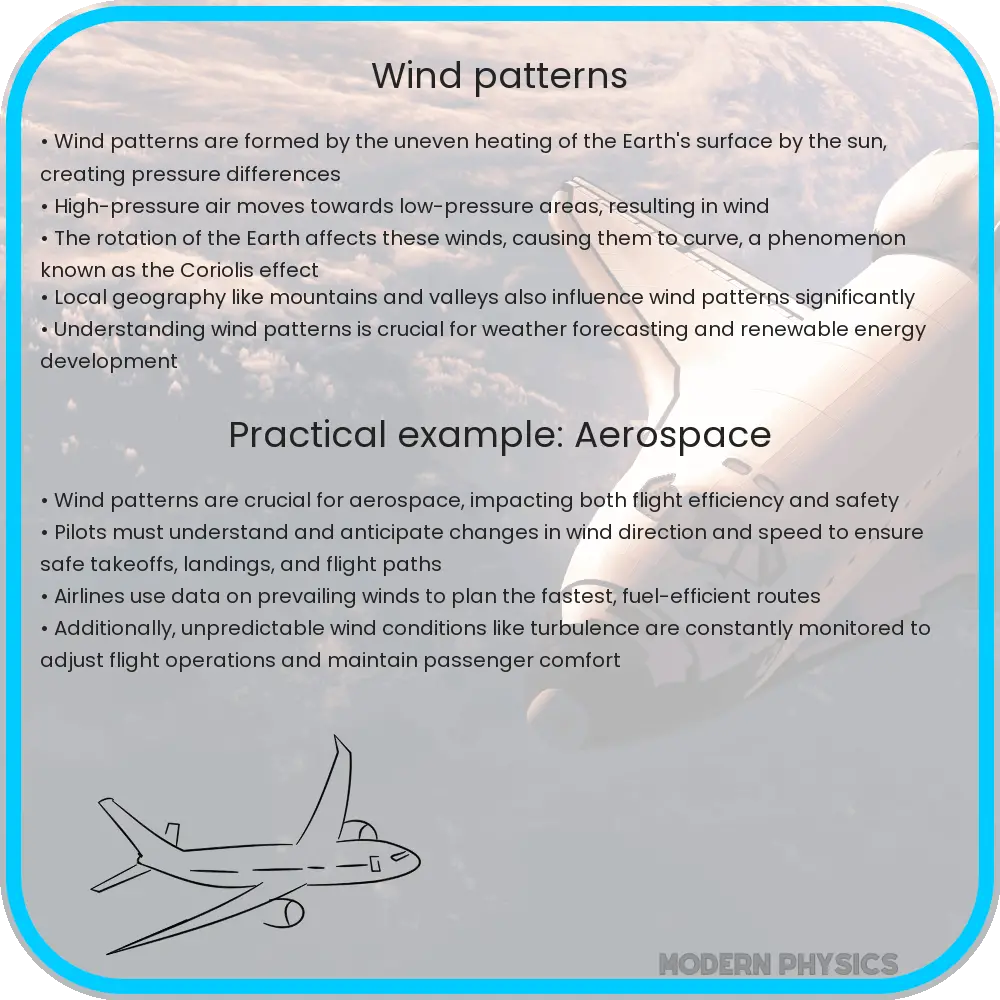Understanding wind patterns involves studying the motion and effects of air due to atmospheric pressure differences and Earth’s rotation, crucial for weather and climate.

Exploring Wind Patterns: Understanding Atmospheric Physics and Climate Impact
Wind patterns play a crucial role in our planet’s climate system. By understanding these patterns, we can explore how they influence weather forecasts, climate change, and even day-to-day weather experiences. This article delves into the physics of wind patterns, their impact on climate, and the methods used for predicting them effectively.
What Are Wind Patterns?
Wind is air in motion, and it’s primarily caused by two factors: differences in atmospheric pressure and the rotation of the Earth. Wind patterns, or the general flow of air around our planet, are guided by planetary-scale systems of high and low pressure. These systems are influenced by the Earth’s rotation, geographical attributes, and temperature variations, among other factors.
Atmospheric Pressure and Winds
Atmospheric pressure refers to the weight of the atmosphere pressing down on the Earth’s surface. It varies from place to place and over time. These variations are largely driven by temperature differences, which are affected by factors such as the angle of sunlight, surface characteristics, and more.
When a region heats up, the air becomes lighter and rises, creating an area of lower pressure. Cooler, denser air from surrounding regions then moves into this low-pressure area. The movement of air from high-pressure areas to low-pressure areas creates wind. This movement and the resulting wind patterns can be described by the wind gradient force equation:
- Wind Gradient Force: Fg = -1/ρ * ∆P / ∆x, where:
- ρ is the air density,
- ∆P is the change in pressure, and
- ∆x is the change in distance.
The Coriolis Effect
One cannot discuss wind patterns without mentioning the Coriolis effect. As the Earth rotates, it influences the direction of the wind. This effect causes the path of the wind to curve rather than moving in a straight line. In the Northern Hemisphere, winds curve to the right, whereas in the Southern Hemisphere, they curve to the left. This deflection is pivotal in shaping wind patterns across the globe.
Major Wind Patterns
There are several persistent wind patterns that are key to understanding global climate:
- Trade Winds: These are steady, easterly winds found in the tropics. They arise due to the interaction between the high pressure in the subtropics and the equatorial low-pressure system.
- Westerlies: Predominantly found in the middle latitudes, these winds flow from west to east, shaped by temperature contrasts between polar and tropical air masses.
- Polar Easterlies: These cold, dry winds blow from the high-pressure areas of the polar highs towards the low-pressure areas of the subpolar lows.
Understanding these wind systems is not only vital for weather prediction but also for grasping the transport mechanisms of atmospheric pollutants and important biogeochemical cycles. The interplay of these winds with ocean currents influences climate patterns, affecting weather conditions on a global scale.
Impact of Wind Patterns on Climate Change
Wind patterns are not just crucial for daily weather conditions but also play a significant role in climate dynamics. Changes in wind patterns can affect the distribution of heat and moisture across the globe, influencing long-term climate variations. For instance, shifts in the trade winds have been linked to phenomena such as El Niño and La Niña, which significantly impact global weather and climate patterns.
Furthermore, wind patterns contribute to the mixing and circulation of the oceans. By driving ocean currents, they help regulate the Earth’s climate by transporting warm water from the equator towards the poles and bringing cold water back toward the equator. This not only affects regional climates but also plays a role in global heat balance and climate systems.
Technologies for Predicting Wind Patterns
Advancements in technology have significantly improved our ability to predict and study wind patterns. Meteorologists use sophisticated tools such as satellites, weather balloons, and radar to gather data on atmospheric conditions. Computer models are then used to simulate wind patterns and predict changes in the atmosphere. These predictions are crucial for preparing for weather-related disasters, planning in aviation and maritime operations, and managing energy resources like wind farms.
Practical Applications of Wind Patterns
The knowledge of wind patterns is applied in various fields. Sailors and pilots use wind pattern information to navigate and ensure safety. Wind patterns also guide the strategic placement of wind turbines in wind farms to optimize energy production. Additionally, understanding wind directions and strengths aids in air quality management by predicting the spread of pollutants and planning urban layouts to mitigate pollution exposure.
Conclusion
Wind patterns are a fundamental aspect of Earth’s atmospheric dynamics, affecting everything from daily weather to global climate systems. By understanding how wind patterns form and their underlying forces, such as atmospheric pressure variations and the Coriolis effect, we can better interpret and predict weather and climate-related phenomena. Advances in technology continue to enhance our predictive abilities, aiding in disaster preparedness and efficient resource management. As we continue to study these dynamic systems, our grasp on Earth’s atmospheric behavior becomes clearer, leading to more informed decisions in environmental planning and management. Thus, the study of wind patterns not only enriches our understanding of the planet but also empowers us to face challenges posed by climate change and environmental sustainability.
